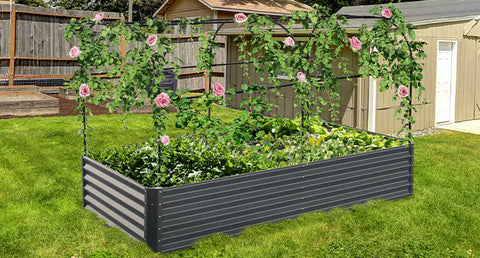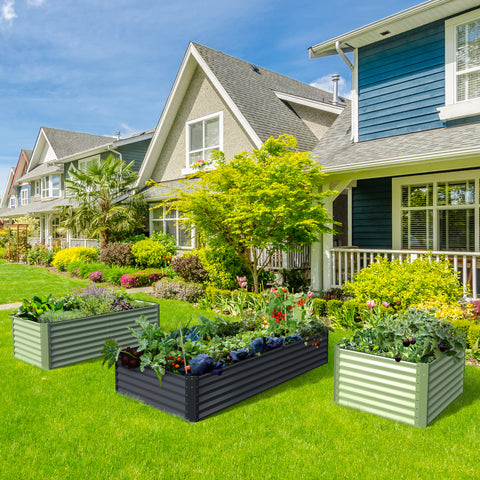If your yard is not to your satisfaction, or you are short on garden space, or you only want a small space dedicated to gardening, building a planting bed can solve all of the above problems. Now let's see how this actually works.The following content also has some reference value for raised garden beds.
Quick method
1 Use old wooden boats. Using a wooden boat can make your garden look unique and also help you master some building or carpentry skills. Search online on Craigslist or find a suitable boat at a local appliance or sailing store. Find an old wooden paddle boat (or similar). It's perfect for use in water, and it's cheap. Paint it any color you like and drill holes in the bottom. Put it where you're going to put it and keep it level. Grooves may be necessary. Put some garden plastic on the bottom, and some rocks or other filling material to make the bottom even. Put in some soil and plants you like
2 Use an old wooden bed frame. You can buy antique bed frames to give your garden bed a fancy look. The downside, of course, is that it's embarrassingly tall, and if it's too big, it's hard to reach the center. A double bed for children is a good idea. If you can only find a suitable board, you can put it under a suitable size bed. If the side panels of the bed frame are intact, you can simply add more boards to make a box. Measure the length of these boards and nail them. Fill with soil and plants.
3 Use an old wine crate. Wine box, orange box, or any similar box that can become a planter box. Drill holes for drainage and fill it with dirt and plants. Place them in your garden bed or on a flat or sloping table.
 Planning project
Planning project
1 Design the shape for your planting bed. Luckily, a flower bed doesn't have to take much work! You basically just make a box with a top opening and a bottom opening, whatever shape you want. Imagine you are making a house out of cement (made of cement or plaster).
2 Sketch out, measure the available garden space, and add to your sketch. Now you can determine how much material you need to build your planting bed.
3 Decide which materials to use. You can use anything, as long as it holds dirt. Wood, plastic, synthetic wood, railroad ties, brick, stone, or some other possible material. However, using wood is generally the simplest and most effective method. This article will focus on how to make wood or synthetic wood.
4 Put all the things you need together and make a list. All you need is the length you need for the side cut and a height of at least 60 centimeters. If you want a triangular planter bed, you need three sides. If you want a square bed, you will need four sides of equal length. A rectangular bed needs four sides, two of the same length. You can choose any shape you want!
Build planting bed
1 Drive piles. Use a 4x4 twice the height of the bed. Dig the hole and stick the 4x4 into the ground and anchor it. Make sure the 4x4 is level and in the right place.
2 Plus the long side plate. Modify the dimensions of the side panels according to the length between the two piles, including the width of the piles themselves. Nail or screw the end of the side plate and the pile together. Place the board at the desired height. Make the last board narrower if necessary
3 Plus short side panels. Cut the distance of the short side plate according to the measured distance between the two long sides. Again, nail or screw the end of the board and the pile together.
4 Add a flange if needed. Adding a flange to the planting bed will make it more attractive. First, make the flange of a type picture frame according to the width you want. Obtain a wood column with flanges as wide and nail it to the top of the bed
5 Cut some garden plastic or weed MATS to put on your planting bed. By placing a few barriers you will greatly reduce weed growth. Seven or eight layers of wet newspaper will also deter weed growth, as will electrical box cardboard (be sure to remove tape from the cardboard)
 Put the planting bed to use
Put the planting bed to use
Method 1 Once your bed has been moved to the spot you intend to place it, fill it with dirt. Add some putrefied organic manure to the bottom of the bed and nutrient-rich compost potting soil to the top. You can use some of your own soil to reduce the cost (50%). Fill with at least 1/3 compost or rancid organic manure (available from garden centers, 40 pound bags). Mix dried organic fertilizers (e.g. wood ash, bone meal, blood meal) when making the bed. Follow the directions on the package.
2 Start planting. Some people like to plant flowers in planting beds. Some people like to grow vegetables. You have a lot of options. If you want to grow food, planting beds are great for leafy greens, carrots, Onions, radishes, beets, and other root tubers.
3 Protect your planting bed from other elements. Build a small organic spring/summer/fall "greenhouse" free from pests that can be vaulted over your bed using curved PVC pipe. The arch measures approximately 4-6 feet (1.2 m to 1.8 m). Buy a floating row cover, also known as a spinning fabric, from a garden supply store or online, clip it to your arch, and you'll be sure to have a pest-free, water-conserving house to grow food in throughout the growing season. As your plant grows taller it's no longer useful to cover it, so you can remove the cover and then use it on the part that can still be covered all the way down to the ground. Strange as it may seem, it is possible to let sunlight, temperature and humidity through a covered curtain, but not bugs and weed seeds. Therefore, doing so will help you reduce the amount of watering, weeding, and pesticide application. You can also use shelves to make plastic netting that restricts birds, if you don't, your efforts may be in vain.
Planting beds are an attractive toilet for cats. If you have rough cats in your neighborhood, plant some catnip to keep them away.In some places, some wood on the ground can cause termite disasters in nearby wood-frame homes. Some older wood that was once pressure-treated -- painted green and often used for outdoor structures -- can contain arsenic, a highly toxic carcinogen. Arsenic is no longer used to treat wood, however old wood can still contain the toxic substance. Arsenic is released when the wood is sawed or burned, and may be released from the wood when the soil is acidic or there is acid rain. Although these woods last longer, you may still stick with regular wood, especially for vegetable beds, and replace them every three to five years.
Newly treated wood no longer contains arsenic. However, recycled wood may still contain the chemical.









